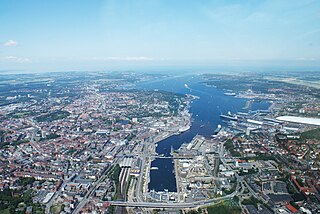
Kiel is the capital and most populous city in the northern German state of Schleswig-Holstein, with a population of 246,243 (2021).

Mutiny is a revolt among a group of people to oppose, change, or remove superiors or their orders. The term is commonly used for insubordination by members of the military against an officer or superior, but it can also sometimes mean any type of rebellion against any force. Mutiny does not necessarily need to refer to a military force and can describe a political, economic, or power structure in which subordinates defy superiors.

Carl Friedrich Heinrich Reinhard Scheer was an Admiral in the Imperial German Navy. Scheer joined the navy in 1879 as an officer cadet and progressed through the ranks, commanding cruisers and battleships, as well as senior staff positions on land. At the outbreak of World War I, Scheer was the commander of the II Battle Squadron of the High Seas Fleet. He then took command of the III Battle Squadron, which consisted of the newest and most powerful battleships in the navy. In January 1916, he was promoted to Admiral and given control of the High Seas Fleet. Scheer led the German fleet at the Battle of Jutland on 31 May – 1 June 1916, one of the largest naval battles in history.

The German Revolution of 1918–1919, also known as the November Revolution, was an uprising started by workers and soldiers in the final days of World War I. It quickly and almost bloodlessly brought down the German Empire, then in its more violent second stage, the supporters of a parliamentary republic were victorious over those who wanted a soviet-style council republic. The defeat of the forces of the far Left cleared the way for the establishment of the Weimar Republic.

Gustav Noske was a German politician of the Social Democratic Party (SPD). He served as the first Minister of Defence (Reichswehrminister) of the Weimar Republic between 1919 and 1920. Noske was known for using army and paramilitary forces to suppress the socialist/communist uprisings of 1919.

The Marinebrigade Ehrhardt, also known as the Ehrhardt Brigade, was a Freikorps unit of the early Weimar Republic. It was formed on 17 February 1919 as the Second Marine Brigade from members of the former Imperial German Navy under the leadership of Hermann Ehrhardt. The Brigade was used primarily in the suppression of the Bavarian Soviet Republic and the First Silesian Uprising, both in the first half of 1919. In March 1920, faced with its imminent disbanding by orders of the government in Berlin, the Marine Brigade was one of the main supporters of the Kapp Putsch that tried to overthrow the Weimar Republic. After the putsch failed and the Brigade was disbanded in May, many of the former members formed the secret Organisation Consul under Ehrhardt's leadership. Before it was banned in 1922, it carried out numerous assassinations and murders in a continuation of the attempts to overthrow the Republic.
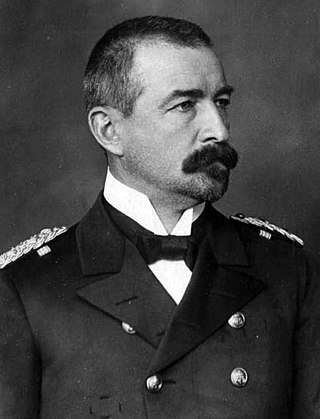
Wilhelm Anton Souchon was a German admiral in World War I. Souchon commanded the Kaiserliche Marine's Mediterranean squadron in the early days of the war. His initiatives played a major part in the entry of the Ottoman Empire into World War I.

SMS Helgoland, the lead ship of her class, was a dreadnought battleship of the German Imperial Navy. Helgoland's design represented an incremental improvement over the preceding Nassau class, including an increase in the bore diameter of the main guns, from 28 cm (11 in) to 30.5 cm (12 in). Her keel was laid down on 11 November 1908 at the Howaldtswerke shipyards in Kiel. Helgoland was launched on 25 September 1909 and was commissioned on 23 August 1911.

The November 1918 insurgency in Alsace-Lorraine is a series of events which occurred when the region of Alsace–Lorraine passed from German to French sovereignty at the end of World War I. During this month, international events were linked to domestic troubles, particularly the German Revolution.
The Cattaro mutiny occurred during World War I. Sailors of the Austro-Hungarian Navy in the Adriatic Bay of Cattaro, which at that time belonged to Austria-Hungary started it on 1 February 1918. The mutiny remained isolated and had to be abandoned after three days due to the arrival of loyal troops. Four sailors were subsequently executed according to naval law. The naval historian Halpern portrays this event as the last victory of the Austro-Hungarian Monarchy over the social forces that would eventually overwhelm it.
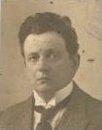
Lothar Popp was a German revolutionary and a leader of the sailors' revolt in Kiel in 1918.

Karl Artelt was a German revolutionary and a leader of the sailors' revolt in Kiel.

Franz Ritter von Hipper was an admiral in the German Imperial Navy. Franz von Hipper joined the German Navy in 1881 as an officer cadet. He commanded several torpedo boat units and served as watch officer aboard several warships, as well as Kaiser Wilhelm II's yacht SMY Hohenzollern. Hipper commanded several cruisers in the reconnaissance forces before being appointed commander of the I Scouting Group in October 1913.
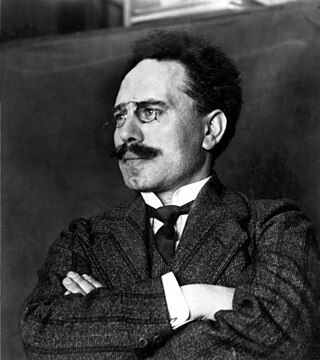
Karl Paul August Friedrich Liebknecht was a German socialist and anti-militarist. A member of the Social Democratic Party of Germany (SPD) beginning in 1900, he was one of its deputies in the Reichstag from 1912 to 1916, where he represented the left-revolutionary wing of the party. In 1916 he was expelled from the SPD's parliamentary group for his opposition to the Burgfriedenspolitik, the political truce between all parties in the Reichstag while the war lasted. He twice spent time in prison, first for writing an anti-militarism pamphlet in 1907 and then for his role in a 1916 antiwar demonstration. He was released from the second under a general amnesty three weeks before the end of the First World War.
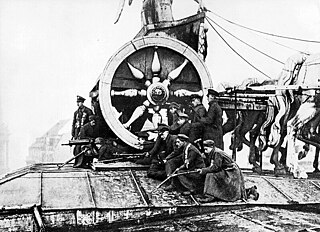
The Spartacist uprising, also known as the January uprising, was an armed uprising that took place in Berlin from 5 to 12 January 1919. It occurred in connection with the November Revolution that broke out following Germany's defeat in World War I. The uprising was primarily a power struggle between the Social Democratic Party of Germany (SPD) led by Friedrich Ebert, which favored a social democracy, and the Communist Party of Germany (KPD), led by Karl Liebknecht and Rosa Luxemburg, which wanted to set up a council republic similar to the one established by the Bolsheviks in Russia. In 1914 Liebknecht and Luxemburg had founded the Marxist Spartacus League, which gave the uprising its popular name.
Richard Stumpf was Roman Catholic, a tinsmith and a member of a Christian trade union. From 1912 to 1918 he served in the High Seas Fleet of the German Imperial Navy. From just before the start of the First World War to its end, he wrote a personal war diary. Because the diary comprehensively represented the internal situation in the fleet from the perspective of a regular sailor, it has been documented in full length by the enquiry commission of the German Weimar Republic parliament (Reichstag) in its investigation report.

Wolfram Wette is a German military historian and peace researcher. He is an author or editor of over 40 books on the history of Nazi Germany, including the seminal Germany and the Second World War series from the German Military History Research Office (MGFA).

The Volksmarinedivision was an armed unit formed on 11 November 1918 during the November Revolution that broke out in Germany following its defeat in World War I. At its peak late that month, the People's Navy Division had about 3,200 members. In the struggles between the various elements involved in the revolution to determine Germany's future form of government, it initially supported the moderate socialist interim government of Friedrich Ebert and the Council of the People's Deputies. By December of 1918 it had turned more to the left and was involved in skirmishes against government troops. In March 1919, after the success of the Ebert government in the elections to the National Assembly that drew up the Weimar Constitution, the People's Navy Division was disbanded and 30 of its members were summarily shot by members of a Freikorps unit.
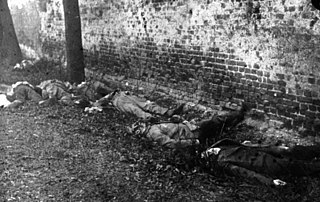
The Berlin March Battles of 1919, also known as Bloody Week, were the final decisive phase of the German Revolution of 1918–1919. The events were the result of a general strike by the Berlin working class to enforce the widely anticipated socialization of key industries, as well as the legal safeguarding of the workers' and soldiers' councils and thus the democratization of the military. The strike action was met with violence from the paramilitary Freikorps, resulting in street fighting and house-to-house fighting around the Alexanderplatz and the city of Lichtenberg.

Magnus Otto Bridges von Levetzow was a German naval officer who rose to the rank of Konteradmiral. He became a Nazi Party politician and served as the Police President of Berlin from 1933 to 1935.

























